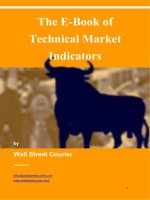A random walk down wall street
Bạn đang xem bản rút gọn của tài liệu. Xem và tải ngay bản đầy đủ của tài liệu tại đây (4.93 MB, 566 trang )
Document
file:///E|/Unposted/Netlib/A%20Random%20Walk%20Down% 047814/nlReader.dll@BookID=32673&FileName=Cover.html [10/7/2007 12:41:52 AM]
Document
Page 3
A Random Walk Down Wall Street
Including A Life-Cycle Guide To Personal Investing
Burton G. Malkiel
Chemical Bank Chairman's
Professor of Economics
At Princeton University
file:///E|/Unposted/Netlib/A%20Random%20Walk%20Down% 0393047814/nlReader.dll@BookID=32673&FileName=3.html [10/7/2007 12:41:53 AM]
Document
Page 4
Copyright © 1999, 1996, 1990, 1985, 1981, 1975,
1973
by W. W. Norton & Company, Inc.
All rights reserved
Printed in the United States of America
The text of this book is composed in Zapf Elliptical with the display set in
Berling.
Desktop composition by Justine Burkat Trubey
Manufacturing by the Haddon Craftsmen, Inc.
Library of Congress Cataloging-in-Publication Data
Malkiel, Burton G.
A random walk down Wall Street : including a life-cycle guide
to personal investing / Burton G. Malkiel.
p. cm.
Rev. ed. of: a random walk down Wall Street. c1996.
Includes bibliographical references and index.
ISBN 0-393-04781-4
1. Investments. 2. Stocks. 3. Random walks (Mathematics)
I. Malkiel, Burton G. Random walk down Wall Street. II. Title.
HG4521 .M284 1999
332.6dc21 98-50671
CIP
W. W. Norton & Company, Inc., 500 Fifth Avenue, New York, N.Y.
10110
W. W. Norton & Company Ltd., 10 Coptic Street, London WC1A 1PU
2 3 4 5 6 7 8 9 0
file:///E|/Unposted/Netlib/A%20Random%20Walk%20Down% 0393047814/nlReader.dll@BookID=32673&FileName=4.html [10/7/2007 12:41:53 AM]
Document
Page 5
To Nancy
file:///E|/Unposted/Netlib/A%20Random%20Walk%20Down% 0393047814/nlReader.dll@BookID=32673&FileName=5.html [10/7/2007 12:41:54 AM]
Document
Page 7
CONTENTS
Preface
13
Acknowledgments from Earlier
Editions
17
Part One
Stocks and Their Value
1. Firm Foundations and Castles in the
Air
23
What Is a Random
Walk?
24
Investing as a Way of Life
Today
26
Investing in
Theory
28
The Firm-Foundation
Theory
29
The Castle-in-the-Air Theory 31
How the Random Walk Is to Be
Conducted
33
2. The Madness of
Crowds
35
The Tulip-Bulb
Craze
36
file:///E|/Unposted/Netlib/A%20Random%20Walk%20Do 3047814/nlReader.dll@BookID=32673&FileName=7.html (1 of 3) [10/7/2007 12:41:54 AM]
Document
The South Sea
Bubble
39
The Florida Real Estate
Craze
45
Wall Street Lays an
Egg
46
An
Afterword
53
3. Stock Valuation from the Sixties through the
Nineties
55
The Sanity of
Institutions
55
The Soaring
Sixties
57
The New "New Era": The Growth-Stock/New-Issue
Craze
57
Synergy Generates Energy: The Conglomerate
Boom
61
Performance Comes to the Market: The Bubble in Concept
Stocks
69
The Sour
Seventies
73
The Nifty
Fifty
73
The Roaring
Eighties
76
file:///E|/Unposted/Netlib/A%20Random%20Walk%20Do 3047814/nlReader.dll@BookID=32673&FileName=7.html (2 of 3) [10/7/2007 12:41:54 AM]
Document
The Triumphant Return of New
Issues
76
Concepts Conquer Again: The Biotechnology
Bubble
78
file:///E|/Unposted/Netlib/A%20Random%20Walk%20Do 3047814/nlReader.dll@BookID=32673&FileName=7.html (3 of 3) [10/7/2007 12:41:54 AM]
Document
Page 8
The Chinese Romance with the Lycoris Plant 80
Some Other Bubbles of the
1980s
81
What Does It All
Mean?
85
The Nervy
Nineties
85
The Japanese Yen for Land and
Stocks
85
The Internet Craze of the Late
1990s
90
A Final
Word
94
4. The Firm-Foundation Theory of Stock
Prices
95
The "Fundamental" Determinants of Stock
Prices
96
Two Important
Caveats
103
Testing the
Rules
106
One More
Caveat
108
What's Left of the Firm
Foundation?
111
file:///E|/Unposted/Netlib/A%20Random%20Walk%20Do 3047814/nlReader.dll@BookID=32673&FileName=8.html (1 of 3) [10/7/2007 12:41:55 AM]
Document
Part Two
How the Pros Play the Biggest Game in Town
5. Technical and Fundamental
Analysis
117
Technical versus Fundamental
Analysis
118
What Can Charts Tell
You?
119
The Rationale for the Charting
Method
124
Why Might Charting Fail to
Work?
126
From Chartist to
Technician
127
The Technique of Fundamental
Analysis
128
Why Might Fundamental Analysis Fail to
Work?
132
Using Fundamental and Technical Analysis
Together
134
6. Technical Analysis and the Random-Walk
Theory
138
Holes in Their Shoes and Ambiguity in Their
Forecasts
138
Is There Momentum in the Stock
Market?
140
file:///E|/Unposted/Netlib/A%20Random%20Walk%20Do 3047814/nlReader.dll@BookID=32673&FileName=8.html (2 of 3) [10/7/2007 12:41:55 AM]
Document
Just What Exactly Is a Random
Walk?
142
Some More Elaborate Technical
Systems
145
The Filter
System
146
The Dow
Theory
146
The Relative-Strength
System
147
Price-Volume
Systems
148
Reading Chart
Patterns
148
Randomness Is Hard to
Accept
149
A Gaggle of Other Technical Theories to Help You Lose
Money
150
file:///E|/Unposted/Netlib/A%20Random%20Walk%20Do 3047814/nlReader.dll@BookID=32673&FileName=8.html (3 of 3) [10/7/2007 12:41:55 AM]
Document
Page 9
The Hemline Indicator 151
The Super Bowl Indicator
153
The Odd-Lot Theory
153
A Few More Systems
155
Technical Market Gurus
155
Why Are Technicians Still Hired?
159
Appraising the Counterattack
160
Implications for Investors
163
7. How Good Is Fundamental Analysis?
165
The Views from Wall Street and Academia
166
Are Security Analysts Fundamentally Clairvoyant?
166
Why the Crystal Ball Is Clouded
170
1. The Influence of Random Events
171
2. The Creation of Dubious Reported Earnings through "Creative"
Accounting Procedures
172
3. The Basic Incompetence of Many of the Analysts Themselves 174
4. The Loss of the Best Analysts to the Sales Desk or to Portfolio
Management
177
file:///E|/Unposted/Netlib/A%20Random%20Walk%20Do 3047814/nlReader.dll@BookID=32673&FileName=9.html (1 of 2) [10/7/2007 12:41:56 AM]
Document
Do Security Analysts Pick Winners? The Performance of the Mutual Funds 178
Can Any Fundamental System Pick Winners?
186
The Verdict on Market Timing
187
The Semi-strong and Strong Forms of the Random-Walk Theory
190
The Middle of the Road: A Personal
Viewpoint
193
Part Three
The New Investment Technology
8. A New Walking Shoe: Modern Portfolio Theory
199
The Role of Risk
200
Defining Risk: The Dispersion of Returns
201
Exhibit
201
Expected Return and Variance: Measures of Reward and Risk
201
Documenting Risk: A Long-Run Study
204
Reducing Risk: Modern Portfolio Theory (MPT)
206
Diversification in Practice
211
9. Reaping Reward by Increasing Risk
220
Beta and Systematic Risk
221
file:///E|/Unposted/Netlib/A%20Random%20Walk%20Do 3047814/nlReader.dll@BookID=32673&FileName=9.html (2 of 2) [10/7/2007 12:41:56 AM]
Document
Page 10
The Capital-Asset Pricing Model (CAPM) 224
Let's Look at the
Record
229
An Appraisal of the
Evidence
232
The Quant Quest for Better Measures of Risk: Arbitrage Pricing
Theory
234
A Summing
Up
237
10. The Assault on the Random-Walk Theory: Is the Market Predictable after
All?
240
Predictable Patterns in the Behavior of Stock
Prices
242
1. Stocks Do Sometimes Get on One-Way Streets 243
2. But Eventually Stock Prices Do Change Direction and Hence
Stockholder Returns Tend to Reverse Themselves
244
3. Stocks Are Subject to Seasonal Moodiness, Especially at the Beginning
of the Year and the End of the Week
247
Predictable Relationships between Certain "Fundamental" Variables and Future
Stock Prices
249
1. Smaller Is Often Better 249
2. Stocks with Low Price-Earnings Multiples Outperform Those with High
Multiples
251
file:///E|/Unposted/Netlib/A%20Random%20Walk%20Do 047814/nlReader.dll@BookID=32673&FileName=10.html (1 of 3) [10/7/2007 12:41:56 AM]
Document
3. Stocks that Sell at Low Multiples of Their Book Values Tend to Produce
Higher Subsequent Returns
253
4. Higher Initial Dividends and Lower Price-Earnings Multiples Have
Meant Higher Subsequent Returns
254
5. The "Dogs of the Dow" Strategy
258
And the Winner
Is . . .
259
The Performance of Professional
Investors
259
Concluding
Comments
267
Appendix: The Market Crash of October
1987
270
Part Four
A Practical Guide for Random Walkers and Other Investors
11. A Fitness Manual for Random
Walkers
277
Exercise 1: Cover Thyself with
Protection
278
Exercise 2: Know Your Investment
Objectives
281
Exercise 3: Dodge Uncle Sam Whenever You
Can
289
Pension Plans and
IRAs
289
file:///E|/Unposted/Netlib/A%20Random%20Walk%20Do 047814/nlReader.dll@BookID=32673&FileName=10.html (2 of 3) [10/7/2007 12:41:56 AM]
Document
Keogh
Plans
290
Roth
IRAs
293
file:///E|/Unposted/Netlib/A%20Random%20Walk%20Do 047814/nlReader.dll@BookID=32673&FileName=10.html (3 of 3) [10/7/2007 12:41:56 AM]
Document
Page 11
Tax-Deferred
Annuities
294
Exercise 4: Be Competitive; Let the Yield on Your Cash Reserve Keep Pace
with Inflation
295
Money-Market Mutual Funds 295
Money-Market Deposit Accounts
297
Bank Certificates
299
Tax-Exempt Money-Market Funds
300
Exercise 5: Investigate a Promenade through Bond Country
301
Zero-Coupon Bonds Can Generate Large Future Returns
302
No-Load Bond Funds Are Appropriate Vehicles for Individual Investors
303
Tax-Exempt Bonds Are Useful for High-Bracket Investors
305
Hot TIPS: Inflation Indexed Bonds
307
Should You Be a Bond-Market Junkie?
309
Exercise 6: Begin Your Walk at Your Own Home; Renting Leads to Flabby
Investment Muscles
310
Exercise 7: Beef Up with Real Estate Investment Trusts
313
Exercise 8: Tiptoe through the Investment Fields of Gold and Collectibles
318
Exercise 9: Remember that Commission Costs Are Not Random Some Are
Cheaper than Others
322
file:///E|/Unposted/Netlib/A%20Random%20Walk%20Do 047814/nlReader.dll@BookID=32673&FileName=11.html (1 of 2) [10/7/2007 12:41:57 AM]
Document
Exercise 10: Diversify Your Investment Steps 324
A Final Checkup
324
12. Handicapping the Financial Race: A Primer in Understanding and Projecting
Returns from Stocks and Bonds
326
What Determines the Returns from Stocks and Bonds? 326
Three Eras of Financial Market Returns
331
Era I: The Age of Comfort
333
Era II: The Age of Angst
334
Era III: The Age of Exuberance
340
The Age of the Millennium
342
Appendix: Projecting Returns for Individual Stocks
347
13. A Life-Cycle Guide to Investing
351
Four Asset Allocation Principles
352
1. Risk and Reward Are Related
352
2. Your Actual Risk in Stock and Bond Investing Depends on the Length of
Time You Hold Your Investment
352
file:///E|/Unposted/Netlib/A%20Random%20Walk%20Do 047814/nlReader.dll@BookID=32673&FileName=11.html (2 of 2) [10/7/2007 12:41:57 AM]
Document
Page 12
3. Dollar-Cost Averaging Can Reduce the Risks of Investing in Stocks and
Bonds
356
4. The Risks You Can Afford to Take Depend on Your Total Financial
Situation
360
Three Guidelines to Tailoring a Life-Cycle Investment
Plan
362
1. Specific Needs Require Dedicated Specific
Assets
363
2. Recognize Your Tolerance for Risk 363
3. Persistent Savings in Regular Amounts, No Matter How Small, Pays Off
367
The Life-Cycle Investment Guide
368
14. Three Giant Steps Down Wall Street
372
The No-Brainer Step: Investing in Index Funds
373
The Index Fund Solution: A Summary
375
A Broader Definition of
Indexing
378
A Specific Index Fund
Portfolio
382
The Tax-Managed Index
Fund
383
The Do-It-Yourself Step: Potentially Useful Stock-Picking
Rules
386
file:///E|/Unposted/Netlib/A%20Random%20Walk%20Do 047814/nlReader.dll@BookID=32673&FileName=12.html (1 of 2) [10/7/2007 12:41:58 AM]
Document
The Substitute-Player Step: Hiring a Professional Wall-Street Walker 391
Risk Level
394
Unrealized Gains
394
Expense Ratios
395
The Morningstar Mutual-Fund Information Service
395
A Primer on Mutual-Fund Costs
398
Loading Fees
399
Expense Charges
399
Comparing Mutual-Fund Costs
400
The Malkiel Step
401
A Paradox
405
Some Last Reflections on Our Walk
406
A Random Walker's Address Book and Reference Guide to Mutual Funds
409
Bibliography
429
Index
445
file:///E|/Unposted/Netlib/A%20Random%20Walk%20Do 047814/nlReader.dll@BookID=32673&FileName=12.html (2 of 2) [10/7/2007 12:41:58 AM]
Document
Page 13
PREFACE
It has now been close to thirty years since I began writing the first edition of A Random Walk Down
Wall Street. The message of the original edition was a very simple one: Investors would be far better off
buying and holding an index fund than attempting to buy and sell individual securities or actively
managed mutual funds. I boldly stated that buying and holding all the stocks in a broad, stock-market
averageas index funds dowas likely to outperform professionally managed funds whose high expense
charges and large trading costs detract substantially from investment returns.
Now, some thirty years later, I believe even more strongly in that original thesis, and there's more than a
six-figure gain to prove it. The chart on the following page makes the case with great simplicity. It
shows how an investor with $10,000 at the start of 1969 would have fared investing in a Standard &
Poor's 500-Stock Index Fund. For comparison, the results are also plotted for a second investor who
instead purchased shares in the average actively managed fund. The difference is dramatic. Through
June 30, 1998, the index investor was ahead by almost $140,000, with her original $10,000 increasing
thirty-one-fold to $311,000. And the index returns were calculated after deducting the typical expenses
(2/10 of 1 percent) charged for running an index fund.
file:///E|/Unposted/Netlib/A%20Random%20Walk%20Down% 393047814/nlReader.dll@BookID=32673&FileName=13.html [10/7/2007 12:41:58 AM]
Document
Page 14
The Value of $10,000 Invested in 1969
Why then a seventh edition of this book? If the basic message hasn't changed, what has? The answer is
that there have been enormous changes in the financial instruments available to the public. A book
meant to provide a comprehensive investment guide for individual investors needs to be updated to
cover the full range of investment products available. In addition, investors can benefit from a critical
analysis of the wealth of new information provided by academic researchers and market
professionalsmade comprehensible in prose accessible to everyone with an interest in investing. There
have been so many bewildering claims about the stock market that it's important to have a book that sets
the record straight.
Over the past quarter century, we have become accustomed to accepting the rapid pace of technological
change in our physical environment. Innovations such as cellular and video telephones, cable television,
compact discs, microwave ovens, laptop computers, the Internet, e-mail, and new medical advances
from organ transplants and laser surgery to nonsurgical methods of treating kidney stones and
unclogging arteries have materially affected the way we live. Financial innovation over the same period
has been equally rapid. In 1973, when the
file:///E|/Unposted/Netlib/A%20Random%20Walk%20Down% 393047814/nlReader.dll@BookID=32673&FileName=14.html [10/7/2007 12:41:58 AM]
Document
Page 15
first edition of this book appeared, we did not have money market funds, NOW accounts, ATMs, index
mutual funds, tax-exempt funds, emerging-market funds, floating-rate notes, inflation protection
securities, equity REITs, Roth IRAs, zerocoupon bonds, S&P index futures and options, and new
trading techniques such as ''portfolio insurance" and "program trading," just to mention a few of the
changes that have occurred in the financial environment. Much of the new material in this book has
been included to explain these financial innovations and to show how you as a consumer can benefit
from them.
This edition takes a hard look at the basic thesis of earlier editions of Random Walkthat the market
prices stocks so efficiently that a blindfolded chimpanzee throwing darts at the Wall Street Journal can
select a portfolio that performs as well as those managed by the experts. Through the past thirty years
that thesis has held up remarkably well. More than two-thirds of professional portfolio managers have
been outperformed by the unmanaged S&P 500-Stock Index. Nevertheless, a number of studies by
academics and practitioners, completed during the 1980s and 1990s, have cast doubts on the validity of
the theory. And the stock market crash of October 1987 raised further questions concerning the vaunted
efficiency of the market. This edition explains the recent controversy and reexamines the claim that it's
possible to "beat the market." I conclude that reports of the death of the efficient-market theory are
vastly exaggerated. I will, however, review the evidence on a number of techniques of stock selection
that are believed to tilt the odds of success in favor of the individual investor.
The book remains fundamentally a readable investment guide for individual investors. As I have
counseled individuals and families about financial strategy, it has become increasingly clear to me that
one's capacity for risk bearing depends importantly upon one's age and ability to earn income from non-
investment sources. It is also the case that the risk involved in most investments decreases with the
length of time the investment can be held. For these reasons, optimal investment strategies must be age
related. Chapter Thirteen, entitled "A Life-Cycle Guide to Investing," should prove very helpful to
people of all ages. This chapter alone is worth the cost of a high-priced appointment with a personal
financial adviser.
Finally, the facts and figures in the book have been completely
file:///E|/Unposted/Netlib/A%20Random%20Walk%20Down% 393047814/nlReader.dll@BookID=32673&FileName=15.html [10/7/2007 12:41:59 AM]
Document
Page 16
revised and updated. I survey the stock and bond markets at the end of the twentieth century and present
a set of strategies that should successfully carry investors into the new millennium.
My debts of gratitude to those mentioned in earlier editions continue. In addition, I must mention the
names of a number of people who were particularly helpful in making special contributions to the
seventh edition. These include James Litvack, Gabrielle Napolitano, Abby Joseph Cohen, James Riepe,
George Sauter, John Bogle, Leila Heckman, Will McIntosh, Keith Mullins, Jim Troyer, Andrew Engel,
Mark Thompson, Steven Goldberg, Willy Spat, and David Twardock. Special thanks go to Walter
Lenhard and Andrew Clarke of The Vanguard Group of Investment Companies, who assembled much
of the financial data on investment returns used in this edition, and to Shane Antos and Jonathan
Curran, who provided indispensable and superb research assistance. Lugene Whitley made
extraordinary contributions in transforming various illegible drafts and dictating tapes into readable
text. Phyllis Durepos also provided valuable typing assistance. Ed Parsons and Mark Henderson of W.
W. Norton provided indispensable assistance in bringing this edition to publication. Patricia Taylor
continued her association with the project and made extemely valuable editorial contributions to the
seventh edition.
My wife, Nancy Weiss Malkiel, made by far the most important contributions to the successful
completion of the past three editions. In addition to providing the most loving encouragement and
support, she read carefully through various drafts of the manuscript and made innumerable suggestions
that clarified and vastly improved the writing. She even corrected several errors that had eluded me and
a variety of proofreaders and editors over the first four editions. Most important, she has brought
incredible joy to my life. No one more deserved the dedication of a book than she.
BURTON G. MALKIEL
PRINCETON
UNIVERSITY
OCTOBER 1998
file:///E|/Unposted/Netlib/A%20Random%20Walk%20Down% 393047814/nlReader.dll@BookID=32673&FileName=16.html [10/7/2007 12:42:00 AM]
Document
Page 17
ACKNOWLEDGMENTS FROM EARLIER EDITIONS
My debts of gratitude to people and institutions who have helped me with the first edition of this book
are enormous in both number and degree. My academic colleagues and friends in the financial
community who have contributed to various drafts of chapters are too numerous to mention. I must
acknowledge explicitly, however, the many who have read through the entire manuscript and offered
extremely valuable suggestions and criticisms. These include Peter Asch, Leo Bailey, Jeffrey Balash,
William Baumol, G. Gordon Biggar, Jr., Lester Chandler, Barry Feldman, William Grant, Sol Malkiel,
Richard Quandt, Michael Rothschild, H. Barton Thomas, and Robert Zenowich. It is particularly
appropriate that I emphasize the usual caveat that the above-named individuals are blameless for any
errors of fact or judgment in these pages. Many have warned me patiently and repeatedly about the
madness of my heresies, and the above list includes several who disagree sharply with my position.
Many research assistants have labored long in compiling information for this book. Especially useful
contributions were made by Barry Feldman, Paul Messaris, Barry Schwartz, Greg Smolarek, Ray
Soldavin, and Elizabeth Woods. Helen Talar
file:///E|/Unposted/Netlib/A%20Random%20Walk%20Down% 393047814/nlReader.dll@BookID=32673&FileName=17.html [10/7/2007 12:42:00 AM]
Document
Page 18
and Phyllis Durepos not only faithfully and accurately typed several drafts of the manuscript, but also
offered extremely valuable research assistance as well. Elvira Giaimo provided most helpful computer
programming. Many of the supporting studies for this book were conducted at Princeton's Financial
Research Center.
A vital contribution was made by Patricia Taylor, a professional writer and editor. She read through two
complete drafts of the book and made innumerable contributions to the style, organization, and content
of the manuscript. She deserves much of the credit for whatever lucid writing can be found in these
pages.
I am also grateful to Arthur Lipper Corporation for permission to use their mutual fund rankings,
Wiesenberger Investment Services for the use of their data in many of my tables, Moody's Investors
Service for permission to reproduce several of their stock charts, Consumers Union for their estimates
of life insurance costs, College Retirement Equities Fund for making available to me James Farrell's
performance studies, and Smith, Barney & Co., Inc. for allowing me the run of their investment library.
My association with W. W. Norton & Company has been an extremely pleasant one, and I am
particularly grateful to my editor, Starling Lawrence, for his invaluable help.
Finally, the contribution of Judith Malkiel was of inestimable importance. She painstakingly edited
every page of the manuscript and was helpful in every phase of this undertaking. This acknowledgment
of my debt to her is the largest understatement of all.
In later editions I have been fortunate to have been able to continue to count on the help of many of
those who assisted in the earlier editions. In addition, I want to express my gratitude for the absolutely
essential assistance of John Bogle, Kelly Mingone, Ian MacKinnon, James Norris, and Melissa
McGinnis of The Vanguard Group of Investment Companies; Donald Peters of T. Rowe Price; Edward
Mathias of The Carlyle Group; Howard Baker of the American Stock Exchange; Frank Wisneski and
Ed Owens of Wellington Management Company; H. Bradlee Perry of David L. Babson & Co.; George
Putnam of Putnam Funds; George S. Johnston of Scudder, Stevens & Clark;
file:///E|/Unposted/Netlib/A%20Random%20Walk%20Down% 393047814/nlReader.dll@BookID=32673&FileName=18.html [10/7/2007 12:42:00 AM]









